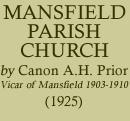< Previous | Contents | Next >
The Church Bells.
The oldest bell in the Tower is the Sixth, which bears date the first year of King James.
In the Old Register, however, we are told that at the King of Scot's proclamation at the Market Cross, on March 31st, 1603, ye belles were rong and the ringers received half-a-crown. We are inquisitive to know what became of these bells. Was the sixth one of them? We scarcely think so. Were these joy bells the same as figured in the Inventory of 1553? Are the 4th, 5th, and 8th bells of to-day the result of melting down the old pre-reformation bells ? Perhaps so, but it is quite impossible to tell.
The Bells were a constant expense to the parish in the old days. They were always being rung and always wanting new bell-ropes, new clappers, new hangings. Often they got cracked, and a new bell had to be provided. They were mostly cast on the spot—generally in the Churchyard.
To carry a big bell, say, twenty or thirty miles over such roads as existed in the XV. Century would be a very serious expense indeed. It was far easier to cast the bell where it was going to be hung, than to drag it along up hill and down dale at the serious risk of breaking it in transit (u).
Tradition says that in Pre-Reformation times the BELL ROPE CLOSE, between the Park and Carr Bank, was left as an endowment for new Bell Ropes by a man who was lost in the Forest by night, and who was guided home by S. Peter's Bells. This close was appropriated to the School in 1857, and is suggestive of the disagreeable fact that the memorable Chancery Award of that year was not so equitable as it might have been, for whatever had the Grammar School in the Churchyard to do with Bell Ropes?
INSCRIPTIONS ON THE EIGHT BELLS.
| 1. | The gift of Robt. Watson (v), Carpenter and Chwarden. Lester and Pack, of London, Fecit, 1762. |
| 2. | At proper times my Voice I'll raise, And sound to my subscribers praise. Lester and Pack, of London, Fecit. |
| 3. | Robt. Watson and Ralph Brocksopp, Churchwardens, 1762. Lester and Pack, of London, Fecit. |
| 4. | Mathy Walker and Thorn Brelsforde, Wardens, 1611 (W). Mark G.L. (X) on either side of a Cross Fleurie. |
| 5. | When thes bels ringe Their friendli gifts are sounded, 1610. Hy. Oldfield mark. T.D. (X) |
| 5. | Thomas Dand and Francis Wass, Churchwardens, 1603. Hy. Oldfield mark. |
| 7. | I sweetly toling men do call To taste on meats that feeds the soule, 1615. Hy. Oldfield mark. |
| 8. | Tow summons by this bel we have, One to the Church, one to the grave. Francis Dand, 1610. Mark G.L. (X) on either side of a shield charged with three crescents. I.R. (X) |
The CLOCK bears the following inscription : Benj. Downs, Fecit, John Durham, Vicar, 1802 ; Joh Rogers, Robert Hitch, Churchwardens.
The Church Plate.
| 1. | A large silver Alms Dish with gadroon edging is inscribed— "The gift of Mrs. Ann Hewitt to the Parish of Mansfield, Sep. ye 21, 1753." In the centre of this beautiful dish IHS is surrounded with a "Glory," and the arms of the Donor are engraved on the rim. |
| 2. | A Chalice with a nearly defaced inscription. Harrod says of this: "What remains legible is 'Churchwardens, 1611,' the words defaced 1 suppose to be the names of the Churchwardens." The Hall Mark corroborates the fact that the date has been correctly interpreted ; And the inscription on the 4th Bell supplies the missing names of the Churchwardens. |
| 3. | A large silver Chalice, standing 13 inches high, and having a bowl 6 inches in diameter, has the Hall Mark of 1702 on it. Being of Queen Anne date, it is valuable. It has inscribed round the rim— "Donum ecclesiae de Mansfield per arnicas duas." |
| 4. | A Paten bears the same Hall Mark and inscription. |
| 5. | A Chalice of silver bearing date 1846 ; inscription, Jas. Bownes and Jas. Carter, Churchwardens. Besides these there is a double set of silver-gilt vessels, but quite modern; date, Xmas. 1879. |
(U) Jessop, Before the Great Pillage, p. 53.
(V) Robert Watson lived in the house (Eight Bells) where Samuel Brunts resided. He constructed some of the windmills on Skerry Hill. He gave one bell himself, and was instrumental in completing the peal, hence the name of the house. (w) These gentlemen appear to have been exceptionally energetic wardens, for it must have been their names that are written on the Chalice dated 1611, although only the word "Churchwardens" is now decipherable.
(x) G.L.—George Lee, travelling foreman for Mr. Oldfield.
T.D.—Thomas Dand.
I.R.—James Rex.
